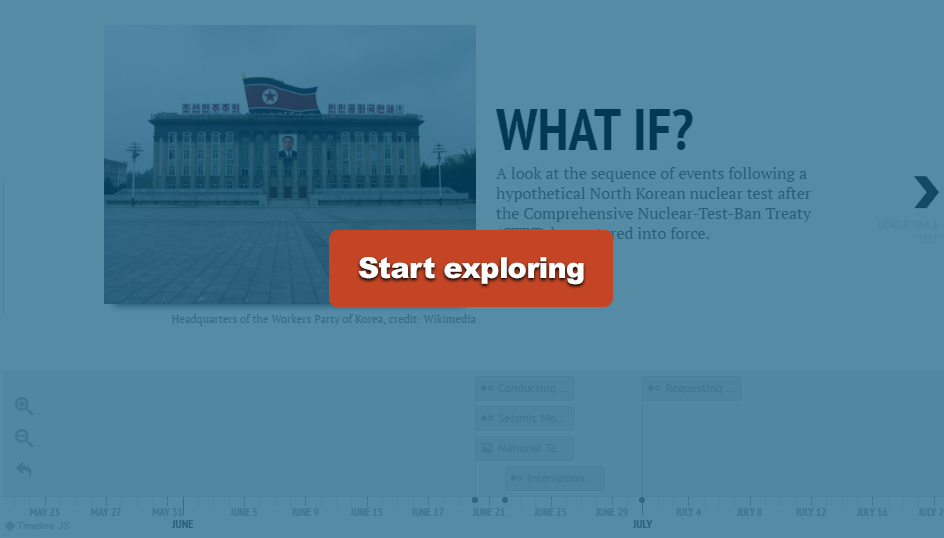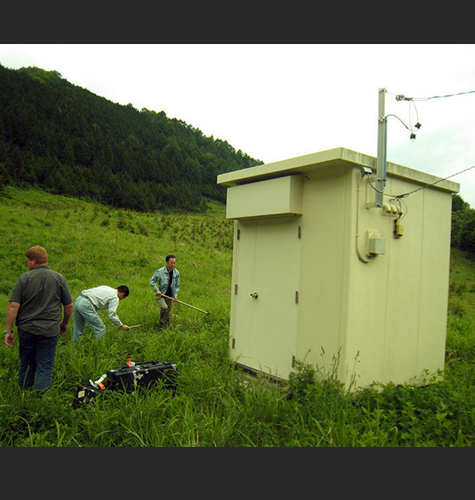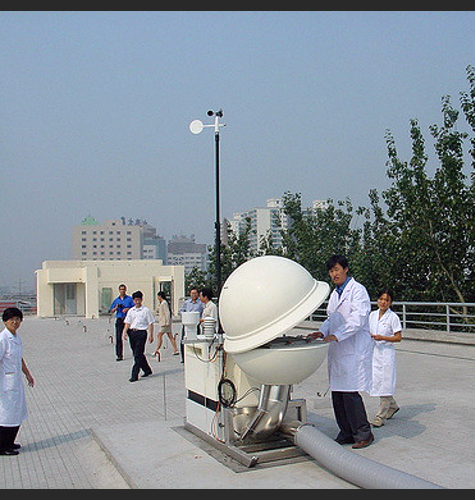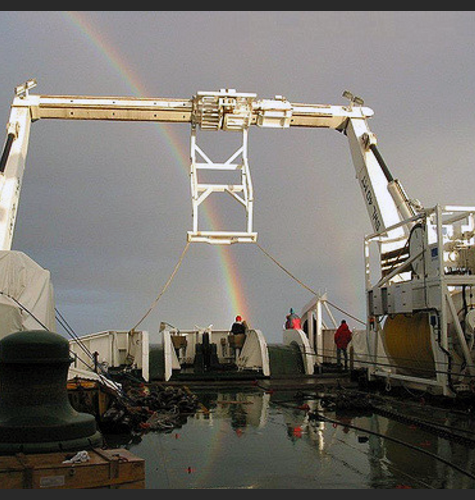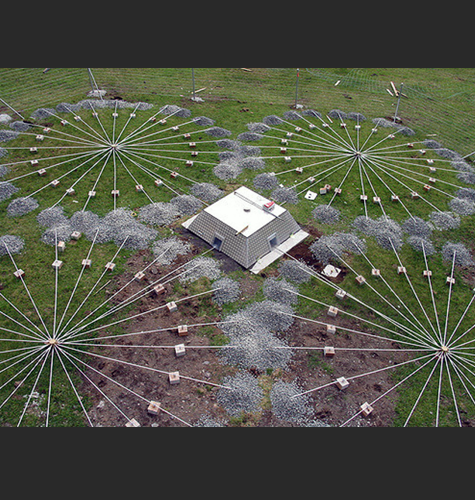Updated: 2023
1. What is verification, and why is it important to a test ban treaty?
According to the United Nations Institute for Disarmament Research, “verification is the process of gathering and analyzing information to make a judgment about parties’ compliance or non-compliance with an agreement. It aims to build confidence between the parties assuring them that their agreement is being implemented effectively and fairly.” [1] In order to achieve these objectives, a verification system performs several functions:
- Detection: an effective verification system must be able to reliably detect violations of the agreement in a timely manner. [2]
- Deterrence: An effective verification system deters potential non-compliance. The higher the likelihood of detection, the less likely a party is to consider violating the agreement. [3]
- Confidence Building: An effective, reliable detection system can build confidence between parties by demonstrating compliance. Verification provides an open, official method for parties to demonstrate their compliance with a treaty or agreement, and to assuage concerns about possible non-compliance. [4]
- Monitoring: All of these functions depend on a monitoring system that reliably obtains the data necessary for verification. [5]
2. What are the key verification provisions of the CTBT?
Ensuring compliance with the CTBT requires the verification of only one thing – that no State Party conducts a nuclear weapon test explosion or any other nuclear explosion. [6] In order to perform this task, a large portion of the treaty text is devoted to describing the CTBTO’s verification system. Some aspects of the CTBT verification system are already in place, but some will not exist until the treaty enters into force.
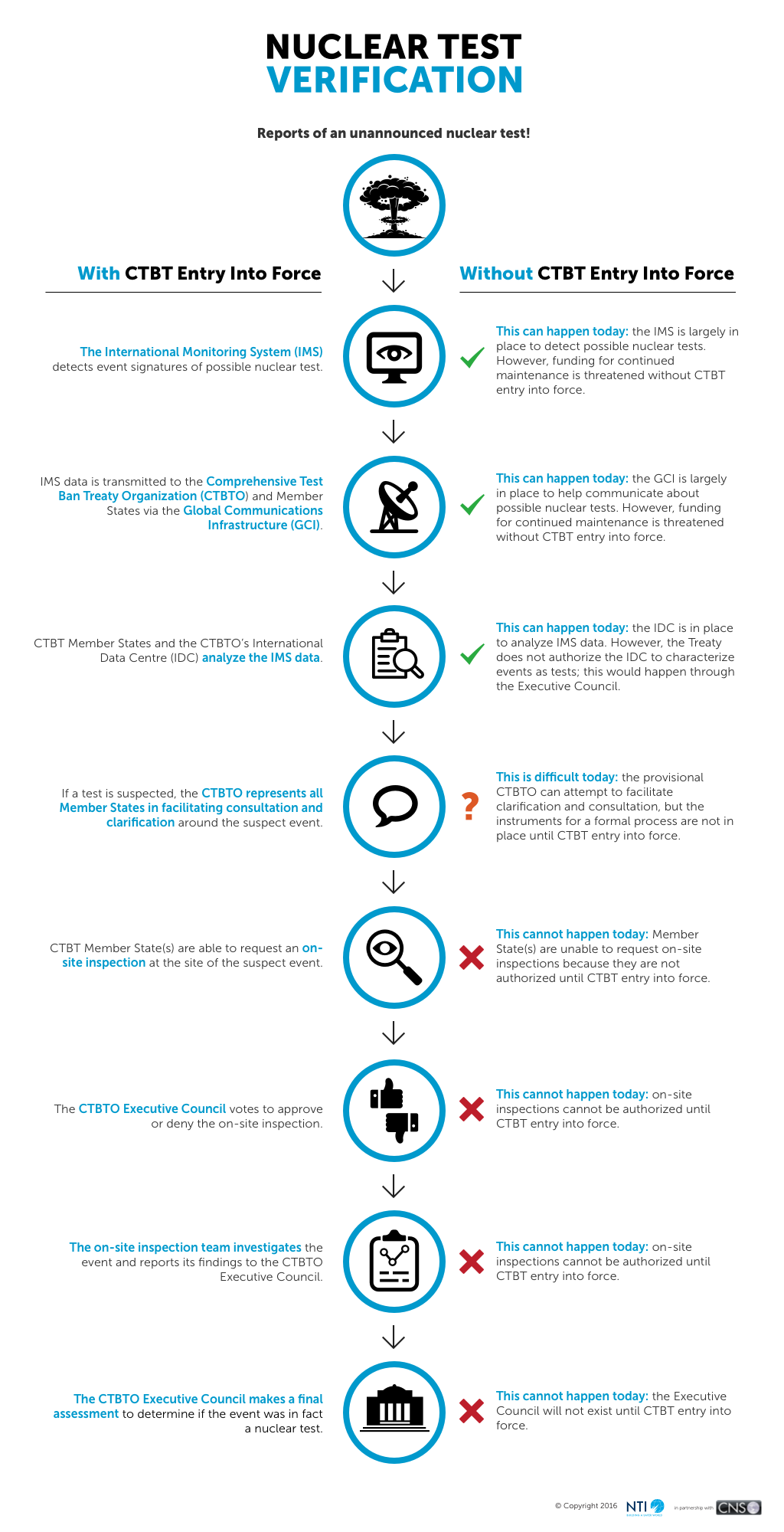
The following timeline describes how the CTBT might respond to a hypothetical illicit nuclear test after the Treaty’s entry into force.
3. How does the International Monitoring System work?
The International Monitoring System is a global network comprising four different types of monitoring stations, each of which can detect unique signatures of a nuclear explosion.
Currently, 83.6% of the planned 337 facilities comprising the IMS are operational with the rest under construction, or in the planning phase, in 89 countries around the world. [7]
4. While the CTBT has not entered into force, is the IMS useful?
While awaiting the CTBT’s entry-into-force the IMS has proven itself capable of detecting nuclear explosions. That the system detected all six of North Korea’s nuclear tests provides strong support for arguments in favor of CTBT ratification in countries that have yet to sign and/or ratify the treaty. [8] [9]
There has been significant controversy among Member States concerning whether IMS data should be available for other uses. The 2004 Indian Ocean Tsunami, which killed more than 200,000 people and was detected by the IMS at a time when data-sharing mechanisms were not in place, helped motivate member state consensus that certain types of data sharing for civil purposes should be permitted.
In recent years, IMS data has been widely used for civil applications, and new uses are being developed on an ongoing basis. Researchers worldwide may submit proposals requesting access to specific datasets. International Data Centre (IDC) Director Randy Bell says approved proposals from individual scientists and researchers have used IDC data for a variety of studies including “everything from marine mammal science to climate change, atmospheric and meteorological modeling, bolide [analysis], [and] seismic analysis…” [10]
Examples include:
Seismic Stations
- These are integral to tsunami warning efforts. In 2011, the IMS detected seismic activity off the coast of Japan, providing the government some time to issue tsunami warnings to its citizens. According to the Preparatory Commission, tsunami-warning centers in 13 countries receive data from approximately 100 CTBTO stations. [11]
Radionuclide Stations
- In 2011, IMS stations detected radioactive particles and noble gases in the air around the Japanese nuclear reactor at Fukushima, signaling a leak in reactor containment, and helped to track the global spread of radioactive contaminants from the Fukushima disaster. [12] Governments and the World Health Organization used the data as part of their relief efforts. [13]
Hydroacoustic Stations
- The stations record whale songs, allowing scientists to monitor specific populations and their migration patterns [14]
- They may be useful in searching for large aircraft lost at sea. Following the crash of Malaysia MH370, hydroacoustic stations detected a noise that came from the Indian Ocean at about the time the plane was believed to have crashed, providing a framework from which to conduct the initial search. [15]
Infrasound Stations
- These can detect volcanic eruptions, the breakup of ice shelves, and meteors for purposes of warning, preparedness, and scientific research. In 2013, 17 of the IMS Infrasound Stations detected the impact of the meteor that landed in Russia, providing scientists with data to determine the size of the meteor. [16]
- The Preparatory Commission is discussing with the International Civil Aviation Organization possibilities for its data to be useful to volcanic ash advisory centers, which work to predict when and where volcanic ash will pose a hazard to air travel.
Sources
[1] United Nations Institute for Disarmament Research and the Verification Research, Training and Information Centre, Coming to Terms with Security: A Handbook on Verification and Compliance, UNIDIR/2003/10, 2003, pg 1.
[2] United Nations Institute for Disarmament Research and the Verification Research, Training and Information Centre, Coming to Terms with Security: A Handbook on Verification and Compliance, UNIDIR/2003/10, 2003, pg 2.
[3] United Nations Institute for Disarmament Research and the Verification Research, Training and Information Centre, Coming to Terms with Security: A Handbook on Verification and Compliance, UNIDIR/2003/10, 2003, pg 3.
[4] United Nations Institute for Disarmament Research and the Verification Research, Training and Information Centre, Coming to Terms with Security: A Handbook on Verification and Compliance, UNIDIR/2003/10, 2003, pg 3.
[5] United Nations Institute for Disarmament Research and the Verification Research, Training and Information Centre, Coming to Terms with Security: A Handbook on Verification and Compliance, UNIDIR/2003/10, 2003, pg 2.
[6] United Nations, CTBT, Comprehensive Nuclear Test-Ban Treaty [New York, N.Y.]: United Nations, Department for Disarmament Affairs and Department of Public Information, 1996: Article I, Paragraph 1; Article IV, Paragraph 2.
[7] “1997-2006: The Pioneering Decade,” CTBTO, Accessed December 22, 2015. https://www.ctbto.org/?id=285
[8] Jonathan Medalia, North Korea’s 2009 Nuclear Test: Containment, Monitoring, Implications, Congressional Research Service (from the Federation of American Scientists), November 24, 2010. https://www.fas.org/sgp/crs/nuke/R41160.pdf; Frederik Dahl, “Monitoring body ‘ready to detect’ any North Korea nuclear test,” Reuters, May 9, 2014. http://www.reuters.com/article/2014/05/09/us-northkorea-nuclear-ctbto-idUSBREA480FL20140509#x3qkDidOp6tKK6I0.97
[9] Robert E. Kelly, “North Korea’s sixth nuclear test: What do we know so far?,” Stockholm International Peace Research Institute, September 5, 2017. https://sipri.org/commentary/expert-comment/2017/north-koreas-sixth-nuclear-test-what-do-we-know-so-far
[10] Timothy Oleson, “Beyond the bomb: The world’s nuclear watchdog expands its science,” Earth Magazine, April 27, 2015. http://www.earthmagazine.org/article/beyond-bomb-worlds-nuclear-watchdog-expands-its-science
[11] Laura Geggel, “Giant ‘Earth Stethoscope’ Spies on Planet’s Wonky Behavior,” Live Science, June 17, 2015. http://www.livescience.com/51250-ctbto-earth-monitoring-system.html
[12] Robert Golan-Vilella, “CTBT Monitors Assist in Fukushima Aftermath,” Arms Control Association, May 3, 2011. https://www.armscontrol.org/act/2011_05/CTBT
[13] Margaret Chan, “Effective Communication in emergencies: The importance of inter-agency collaboration during the Japan disasters,” CTBTO Spectrum, March 2012. https://www.ctbto.org/fileadmin/user_upload/pdf/Spectrum/2012/Spectrum_18_p30.pdf
[14] “The Hydroacoustic Network and How It Works,” CTBTO Preparatory Commission, accessed November 12, 2015. https://www.ctbto.org/verification-regime/monitoring-technologies-how-they-work/hydroacoustic-monitoring/
[15] Declan Butler, “Sound Clue in Hunt for MH370,” Nature, June 11, 2014. http://www.nature.com/news/sound-clue-in-hunt-for-mh370-1.15390
[16] Margaret Campbell-Brown, “The Chelyabinsk meteor: Massive blast detected by 17 infrasound stations,” CTBTO Spectrum, July 2013. https://www.ctbto.org/fileadmin/user_upload/pdf/Spectrum/2013/Spectrum20_p32.pdf
Photo Credit
Header Image: IAEA Safeguard Inspectors. Source: IAEA via Flickr.
